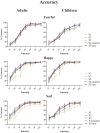Facial expression training optimises viewing strategy in children and adults
- PMID: 25144680
- PMCID: PMC4140761
- DOI: 10.1371/journal.pone.0105418
Facial expression training optimises viewing strategy in children and adults
Abstract
This study investigated whether training-related improvements in facial expression categorization are facilitated by spontaneous changes in gaze behaviour in adults and nine-year old children. Four sessions of a self-paced, free-viewing training task required participants to categorize happy, sad and fear expressions with varying intensities. No instructions about eye movements were given. Eye-movements were recorded in the first and fourth training session. New faces were introduced in session four to establish transfer-effects of learning. Adults focused most on the eyes in all sessions and increased expression categorization accuracy after training coincided with a strengthening of this eye-bias in gaze allocation. In children, training-related behavioural improvements coincided with an overall shift in gaze-focus towards the eyes (resulting in more adult-like gaze-distributions) and towards the mouth for happy faces in the second fixation. Gaze-distributions were not influenced by the expression intensity or by the introduction of new faces. It was proposed that training enhanced the use of a uniform, predominantly eyes-biased, gaze strategy in children in order to optimise extraction of relevant cues for discrimination between subtle facial expressions.
Conflict of interest statement
Figures





References
-
- Carton JS, Kessler EA, Pape CL (1999) Nonverbal decoding skills and relationship well-being in adults. J Noverb Behav 23: 91–100.
-
- Nowicki S Jr, Duke MP (1994) Individual differences in the nonverbal communication of affect: The diagnostic analysis of nonverbal accuracy scale. J Noverb Behav 19, 9–35.
-
- Durand K, Gallay M, Seigneuric A, Robichon F, Baudouin J (2007) The development of facial emotion recognition: The role of configural information. J Exp Child Psychol 97: 14–27. - PubMed
-
- Gao X, Maurer D (2010) A happy story: Developmental changes in children's sensitivity to facial expressions of varying intensities. J Exp Child Psychol 10: 67–86. - PubMed
-
- Widen SC (2013) Children's interpretation of facial expressions: The long path from valence-based to specific discrete categories. Emotion Rev 5: 72–77.
Publication types
MeSH terms
LinkOut - more resources
Full Text Sources
Other Literature Sources

